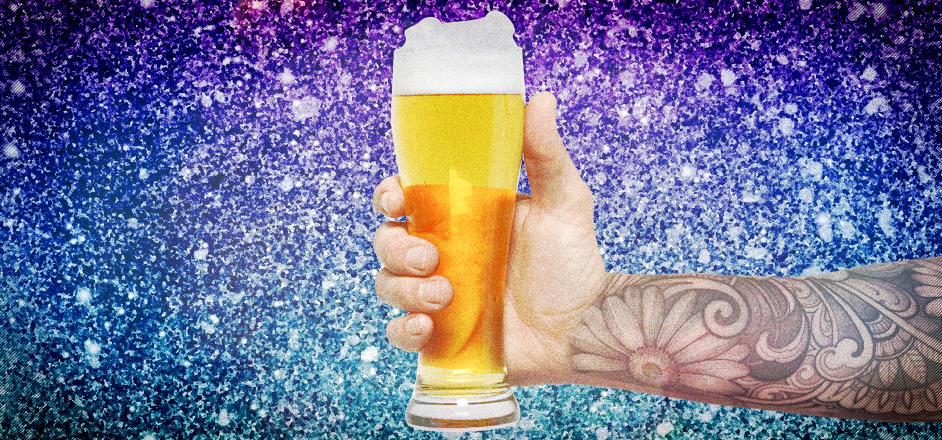The Internet cracked last week, not over another Trump blunder or celebrity breakup, but over glitter beer.
Munchies noted a widespread trend of domestic breweries debuting their own sparkling drafts, noting Three Weavers in California, Bold Missy Brewery in North Carolina, Minocqua Brewing Company in Wisconsin, and Colorado’s Ska Brewing.
Wait … Ska Brewing?
For those familiar with the music-inspired brewery of badasses, it seemed out of character for the Legion of Ska to follow a trend as glitzy as glitter beer. Not that there’s anything necessarily wrong with adding sparkle to your brews … it’s just not Ska.
Sure enough, Ska has not jumped on the glitter beer bandwagon, even taking to Twitter to dispel rumors they are a part of the luster bunch. The company tweeted: “Not sure where they got the idea @skabrewing puts glitter in our brews. ‘Cuz… no. #bitternotglitter.” One follower commented they received credit for going glitter “because there was a Wynkoop glitter beer at the Anniversary party a few years back.”

Ska went on to mock the trend once more saying, “Pink Beet Beer? Yes. Spirit Animal Parties? You Betcha. Curry Collaboration Beer? Damn straight. #glitterBeer? Nuh-uh.”

Before trashing the trend, which gained a buzz leading up to St. Patrick’s day given the glitter beer’s gold shimmer, we spoke with Erica DeAnda, Brewmaster at Minocqua Brewing Company, to ask: why a glitter beer? (And will it make our poop look like a Lisa Frank sticker?)
To answer the most important question, no, like the lore of Goldschläger (that golden flakes tear up your insides while drinking, therefore getting you drunk faster), glitter beer is not going to harm or even colorize your digestive tract. Using Edible luster dust — a decorating powder used commonly on cakes and candies — a brewer can safely add the powder mix into drinks. While luster dust comes in a variety of colors, the most commonly used shades are silver and gold — most breweries using gold for their glitter beers.

“I’ve done a few glitter beers before,” says DeAnda. “I take a core beer I’ve already brewed and add FDA-approved edible baking glitter.” This proves to us that a great beer can still be great even if it sparkles. “I know some brewers make a specific glitter beer, but I just make small batches for special events and beer festivals.”
DeAnda credits her first glitter beer experience to Three Weavers, who brought their Mel’s Sparkle PoI glitter beer to the Cali beer festival, Brewbies. Mel’s Sparkle PoI is an IPA with glitter. “I was so in love with the beer and how amazing it was to see something like this. It elevated my beer tasting experience because not only did the beer taste great but it was pretty! It was cool to see something that is usually regarded as a 'man’s drink' have sparkles in it. It was beautiful, and their head brewer was kind enough to share her process with another brewer girlfriend of mine, who then shared it with me.”
The last glitter beer DeAnda made was Minocqua’s Large Mouth Blonde ale, with rose gold glitter for New Year’s Eve. “It’s 4.5 percent ABV. I buy edible baking glitter from a cake supply store. They sell all kinds of different colors, it’s completely safe to consume and washes out of all brewery equipment because of how quickly it breaks down and dissolves.” And she attests both men and women have gone H.A.M. over the glittery brewskies.

But how does it taste? “You can’t taste the glitter, but if you add too much you can run the risk of having a slight mouth feel to it," DeAnda says. "But with how much I use you still get the regular mouth feel of the beer.”
DeAnda is all about sharing the love, passing along the process to other brewers she knows in the industry. But don’t be expecting an Oreo-pumpkin-sour beer, or any other bizarre trend, coming from her brewery. “Glitter is about as extreme as I get," she says. "For the most part, when it comes to beer, I’m a purest. I have a strong background in English cask ale which tend to be very balanced and not very experimental. But it’s cool, even though I’m a brewer I’m still a girly girl who enjoys shiny things.”
Whether or not glitter takes over, the reality is that some women love it, and are bringing it into the beersphere — remember, women started the craft beer phenomenon, after all. In ancient civilizations, it was the ladies who brewed for their families and sold off the excess. And beer in ancient Egypt was almost solely produced and sold by women. Later, when the U.S. was colonized, women were the primary brewers, producing beer made from ingredients like corn, oats, wheat and honey. Brewing didn't become a male dominated industry until the Industrial Revolution.
So chill out haters, and drink the damn sparkles, sissies.




Leave a Reply